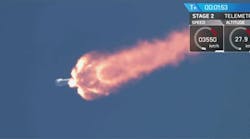Elon Musk’s SpaceX flew a reused rocket to space and back again, a key milestone to reducing launch costs and one day enabling people to live on other planets.
A SpaceX Falcon 9 rocket rumbled aloft, deposited a customer’s satellite into orbit, stuck its landing on a drone ship in the Atlantic Ocean and drew raucous cheers from the crowd gathered Thursday at the company’s California headquarters. The moment was 15 years in the making for Musk, who founded SpaceX with the eventual goal of colonizing Mars.
“This is going to be, ultimately, a huge revolution in spaceflight,” Musk, 45, said from NASA’s Kennedy Space Center in Cape Canaveral, Florida.
Much of the expense of space travel lies in building boosters and other equipment that are typically used once and then discarded. Billionaires including Musk and Amazon.com Inc. founder Jeff Bezos are racing to make rocket reusability -- once dismissed as a crazy idea -- a reality that will dramatically reduce costs.
Closely held Space Exploration Technologies Corp. builds its rockets and engines in-house, wagering this better enables constant improvements and tighter collaboration on design and manufacturing. The rocket launched Thursday carried a communications satellite from Luxembourg’s SES SA that will provide coverage to Latin America.
The reused rocket first took off and landed successfully on an unmanned drone ship bobbing in the Atlantic back in April 2016. The company has now recovered nine rockets in total, three by land and six by sea.
Recovering and refurbishing the used rocket booster that flew Thursday took SpaceX roughly four months, President Gwynne Shotwell said earlier this month. Eventually, that turnaround time will drop to a single day as the company seeks to reuse rockets much in the way airlines operate today.
SpaceX has launched four rockets this year and aims to fly 20 to 24 missions in 2017. The Hawthorne, California-based company has contracts with the National Aeronautics and Space Administration valued at $4.2 billion to resupply the International Space Station using its unmanned Dragon spacecraft. It’s later planning to ferry astronauts to the station with a version capable of carrying crews.
“Congrats @SpaceX on another historic launch!” NASA tweeted Thursday.
SES, which has flown with SpaceX twice before, was the first commercial satellite operator to launch with the company back in 2013. Though the price of the launch was not disclosed, Chief Technology Officer Martin Halliwell said SES received a discount for being first in line.
Musk announced last month that SpaceX plans to send two private citizens who paid “significant deposits” on a week-long flight circling the moon in late 2018.
“I’m sort of at a loss for words,” Musk said Thursday. “It’s really a great day, not just for SpaceX but for the space industry as a whole and proving that something could be done that many people said was impossible.”
Go to the 18:46 mark to see the lift off:










